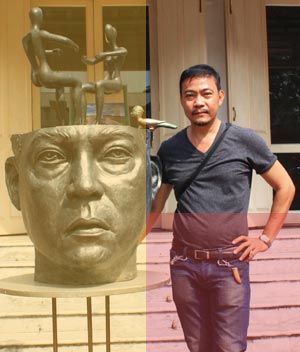Introduction
30 Years Retrospective
Consciousness in Memory
My work is like a monument of memory or a museum of time as I believe that the lives of human beings are really empty. You are born, then you die. The only thing left are the memories of those still alive. In life, all human beings survive on memories. Everyone has memories. For some, they may want to forget them all. Some may want to cherish them to the day they die, as if they are the most precious of all treasures. No one can throw away or rob you of your memories as long as you have a sound mind. Some people use their memories as an elixir that keeps their soul intact until the day they bid goodbye to the earth.
Over a rather long period of time, I have tried to compile my work as much as I could. There is a great diversity in the type of work in the collection. I remember that when I was a child, I started sculpting before drawing. I molded clay into little Buddha images, looking to the Buddha images on the pedestal for examples. My father took me to Khao Din zoo and I came home and sculpted little animals. I could handle a pencil before I started school but I remember vividly that in second grade, the United States sent a man to the moon. Back then, our house did not have a television. I saw it at school. I came home and drew a spaceman, like the one I saw in the television, as well as a rocket and the lunar module into my notebook. I was very advanced as I used thick paper from a cigarette carton to draw on. Then I cut it, rolled it up, and folded it into a rocket that could be taken apart into pieces. I made a spaceship to explore the moon too, being the child I was. Once I grew up a bit, I started painting pictures of the King from his picture on the red 100 baht banknote. I remember I used a number ‘0’ paintbrush with great detail, trying to make my painting look just like that on the banknote. Once I got to high school, I had progressed to the point of having bought oil colours to paint with trace pictures of the King holding a sword from Raden Mazuki calendar, I would use poster colours to trace Thai art off the cover of Chao Krung magazine and trace literary characters from books on "Elaborate Imagery of Thai Literature."
 |
At the Library of Wat Rachathiwat where I went to high school, they had encyclopedias of art. I asked the librarian if I could borrow them out to use as models at home although, usually, school libraries do not allow students to take those kinds of books out. I am indebted to that librarian. She must have seen something in rne. I traced and painted Jan Vermeer's `The Milkmaid,' Peter Paul Rubens' portrait of him and his wife, and Diego Velasquez's 'The Old Woman Frying Eggs.' All of these works were gone after we moved houses. The only painting left was a landscape painting with a reflective shadow and a woman walking. I do not know the name of the artist. Then, once I finished my studies at Silpakorn University, I started sculpting likenesses for money and also worked on my own art. At first, I thought these two jobs were separate from each other but after a while, I started to feel like they both were related to one another. The contracted work provided a means to nourish my body. The personal artwork nourished my soul. When doing my personal work,
the paintings seemed more detailed, deep, and lively than the portraits I was hired to do. The contracted jobs did not seem like art. In doing art, you must have inspiration and skill in sculpting likenesses of people or animals, as can be seen in the works of artists of previous generations like Ajarn Sanan Silakarn, Ajarn Pithoon Muengsomboon, or even Isamu Noguchi.
I do not know if it was coincidence or fate that I am still working in art when almost all of my classmates have stopped. There may be some still doing art but they are not very serious. This made me realize in the philosophy that `If you do not forsake art, art will not forsake you.'
Manop Suwanpinta
April 20, 2012
|

